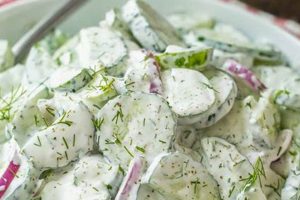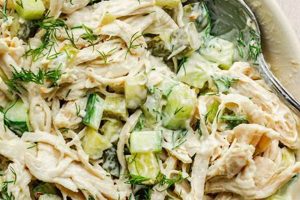Combining cooked chicken, mayonnaise, and seasonings forms the foundation of a classic chicken salad. The addition of apples introduces a contrasting sweetness and crisp texture, elevating the dish beyond the ordinary. A simple version might involve diced chicken, mayonnaise, celery, and diced apple, while more complex iterations can include grapes, nuts, dried cranberries, or curry powder.
The refreshing taste and textural complexity offered by apple-enhanced chicken salad contribute to its widespread popularity. This dish offers a versatile, protein-rich meal option, suitable for picnics, sandwiches, salads, or appetizers. Historically, chicken salad emerged as a way to utilize leftover cooked chicken, evolving over time with regional variations and the incorporation of diverse ingredients like apples to enhance flavor and appeal. The blending of sweet and savory elements offers a balanced flavor profile that appeals to a broad range of palates.
This exploration will delve further into various apple types suitable for chicken salad, offer tips for achieving optimal texture and flavor, and present a selection of recipes demonstrating the versatility of this popular dish. From classic preparations to innovative combinations, the possibilities for crafting a delicious and satisfying apple-infused chicken salad are vast.
Tips for Preparing Apple-Enhanced Chicken Salad
Achieving optimal flavor and texture requires attention to detail. The following tips offer guidance for creating a superior culinary experience.
Tip 1: Apple Selection: Opt for crisp, tart apples such as Granny Smith, Honeycrisp, or Fuji. These varieties hold their shape well and provide a refreshing contrast to the richness of the mayonnaise and chicken.
Tip 2: Preventing Browning: To prevent enzymatic browning, toss diced apples with a small amount of lemon juice immediately after cutting. This helps maintain an appealing appearance and fresh flavor.
Tip 3: Chicken Preparation: Utilizing high-quality cooked chicken contributes significantly to the overall taste. Rotisserie chicken offers convenience, or poaching or grilling chicken breasts provides excellent control over flavor and texture.
Tip 4: Mayonnaise Selection: Full-fat mayonnaise creates a richer, creamier salad. Reduced-fat or Greek yogurt alternatives can be substituted for a lighter version, though this may impact the overall flavor and texture.
Tip 5: Balancing Flavors: Consider incorporating complementary ingredients such as celery, red onion, grapes, walnuts, or dried cranberries to enhance the flavor profile and add textural complexity. Herbs like tarragon or dill can also provide a subtle, aromatic lift.
Tip 6: Seasoning: Salt, pepper, and a touch of Dijon mustard are essential seasonings. Experimenting with curry powder, smoked paprika, or other spices can add unique flavor dimensions.
Tip 7: Chilling: Chilling the salad for at least 30 minutes before serving allows the flavors to meld and enhances the overall experience.
By following these guidelines, one can create a chicken salad that is both flavorful and visually appealing. Attention to these details elevates a simple dish into a culinary masterpiece.
These insights provide a strong foundation for crafting exceptional chicken salad. The following section will explore various recipe variations, offering inspiration for both novice and experienced cooks.
1. Apple Variety
Apple variety plays a crucial role in the overall success of chicken salad. The apple’s characteristics, including sweetness, tartness, and texture, directly influence the final dish. A well-chosen apple provides a necessary counterpoint to the richness of the mayonnaise and the savory chicken, creating a balanced flavor profile. For example, a crisp, tart apple like a Granny Smith offers a refreshing contrast and maintains its texture well, preventing the salad from becoming overly sweet or mushy. Conversely, a sweeter apple like a Fuji or Gala, while contributing a different flavor dimension, might not offer the same textural integrity, potentially leading to a softer, less desirable consistency.
The selection process should consider the desired balance of sweetness and tartness. Tart apples contribute a bright, acidic note that cuts through the richness of the other ingredients. Sweeter apples offer a more mellow flavor profile. Textural considerations are equally important. Firmer apples retain their crispness, while softer apples may become mushy when combined with the other ingredients. Understanding these nuances allows for informed decisions regarding apple selection, contributing significantly to the overall culinary experience.
Selecting the appropriate apple variety elevates chicken salad from simple to exceptional. This attention to detail ensures a harmonious blend of flavors and textures, resulting in a more satisfying and enjoyable culinary creation. Careful consideration of apple characteristics provides a foundation for achieving the desired balance and complexity in chicken salad recipes.
2. Chicken Preparation
Chicken preparation significantly impacts the final character of chicken salad incorporating apples. The cooking method influences the meat’s texture, moisture content, and ability to absorb flavors. Poaching yields tender, moist chicken, readily absorbing the flavors of the apples, mayonnaise, and seasonings. Roasting creates a richer, more intense chicken flavor, offering a robust counterpoint to the sweetness of the apples. Shredding or dicing the cooked chicken further determines the salad’s texture, with larger pieces providing more substantial bites and smaller pieces creating a smoother consistency. Overcooked, dry chicken results in a less palatable salad, while undercooked chicken presents food safety concerns.
Consider the interplay between chicken preparation and other ingredients. Roasted chicken, with its caramelized exterior, pairs well with bolder flavors, perhaps incorporating pecans and dried cranberries. Poached chicken, being more delicate, complements subtler additions like grapes and tarragon. The chosen cooking method should align with the overall flavor profile envisioned for the salad. For example, a smoky grilled chicken might overwhelm the delicate sweetness of apples, while poached chicken provides a neutral base that allows the apple flavor to shine.
Proper chicken preparation is essential for a successful chicken salad. It influences not only the chicken’s taste and texture but also its interaction with other components. Selecting the appropriate cooking method and achieving the correct doneness ensure a harmonious blend of flavors and a pleasant textural experience. This understanding allows for informed choices, enhancing the overall quality and enjoyment of the dish.
3. Mayonnaise Choice
Mayonnaise serves as the foundational binding agent in chicken salad, profoundly influencing the final product’s flavor, texture, and overall quality. Selecting the appropriate mayonnaise is crucial, particularly when incorporating the contrasting sweetness and crispness of apples. The choice impacts not only the salad’s richness and creaminess but also how the other ingredients interact and contribute to the overall sensory experience. A thoughtful approach to mayonnaise selection elevates this seemingly simple dish.
- Full-Fat Mayonnaise
Traditional full-fat mayonnaise offers a rich, creamy texture and classic flavor profile that complements the savory chicken and provides a backdrop for the sweetness of apples. Its higher fat content contributes to a luxurious mouthfeel and helps to bind the ingredients effectively. However, this richness can also overshadow more delicate flavors if used in excess.
- Reduced-Fat Mayonnaise
Reduced-fat mayonnaise offers a lighter alternative, appealing to those seeking a lower-calorie option. However, its reduced fat content can compromise the creaminess and overall flavor intensity, potentially resulting in a less satisfying salad. The lighter texture may also affect the salad’s ability to hold its shape.
- Greek Yogurt
Greek yogurt presents a tangier, protein-rich alternative to traditional mayonnaise. Its lower fat content and distinct flavor profile create a lighter, brighter chicken salad. The tanginess can complement the sweetness of apples, while the thicker consistency provides adequate binding. However, this substitution can introduce a noticeable tang that may not appeal to all palates.
- Homemade Mayonnaise
Crafting homemade mayonnaise allows for complete control over ingredients and flavor profiles. Experimenting with different oils, vinegars, and seasonings enables customization to perfectly complement the specific apple variety and other incorporated ingredients. This offers the opportunity to create a unique and personalized chicken salad experience, but requires additional preparation time and effort.
The chosen mayonnaise interacts directly with the other ingredients, influencing the overall balance and harmony of flavors. Full-fat mayonnaise enhances richness, while lighter options offer a different textural and flavor experience. Understanding these nuances empowers informed decision-making, ensuring the mayonnaise complements the apples and other components, resulting in a well-balanced and enjoyable chicken salad.
4. Complementary Ingredients
Complementary ingredients significantly enhance the complexity and balance of chicken salad with apples. These additions contribute textural contrast, nuanced flavors, and visual appeal, transforming a simple dish into a more sophisticated culinary experience. Consideration of these ingredients is essential for achieving a well-rounded and satisfying salad. The interplay between these additions and the core componentschicken, apples, and mayonnaisecreates a dynamic flavor profile that elevates the dish beyond its basic elements.
Textural variety is a key aspect of a successful chicken salad. The inherent creaminess of mayonnaise and the crispness of apples benefit from the incorporation of ingredients that offer contrasting textures. Nuts, such as walnuts or pecans, introduce a satisfying crunch, while celery provides a refreshing snap. Dried cranberries offer a chewy element, and grapes contribute a juicy burst. These varied textures create a more engaging and enjoyable eating experience. For example, the smooth texture of mayonnaise combined solely with diced apples and chicken can become monotonous. The addition of chopped walnuts, however, immediately introduces a contrasting crunch that elevates the overall sensory experience.
Flavor complexity is another dimension enhanced by complementary ingredients. The sweetness of apples and the savory nature of chicken provide a foundation upon which to build a more intricate flavor profile. Red onion introduces a sharp bite, while fresh herbs like tarragon or dill provide a subtle aromatic complexity. Spices, such as curry powder or smoked paprika, can introduce entirely new flavor dimensions, transforming the character of the salad. These additions create a more layered and nuanced flavor profile, preventing the dish from tasting one-dimensional. A chicken salad featuring Granny Smith apples, for instance, benefits from the addition of dried cranberries, which provide a complementary sweetness and tartness. The combination creates a more balanced and complex flavor profile than either ingredient would achieve alone. Careful selection of complementary ingredients is essential for maximizing flavor complexity.
5. Seasoning Balance
Seasoning balance is paramount in chicken salad recipes featuring apples. It elevates the dish beyond simple ingredients, creating a harmonious blend of flavors that complements the inherent sweetness of the apples and the savory notes of the chicken. Careful consideration of seasonings prevents the salad from tasting bland or, conversely, overly seasoned, ensuring a nuanced and enjoyable culinary experience. Achieving this balance involves understanding the interplay of salt, pepper, acids, and herbs, and how these elements interact with the other components of the salad.
- Salt
Salt enhances the flavors of all ingredients, acting as a foundational seasoning element. It amplifies the sweetness of the apples and balances the richness of the mayonnaise. However, excessive salt can overpower the delicate flavors, making the salad unpalatable. The appropriate amount of salt depends on the saltiness of other ingredients, such as the chicken or any added nuts or cheeses. Kosher salt is often preferred for its clean flavor and ease of use.
- Acid
Acidity provides brightness and complexity, counteracting the richness of the mayonnaise and complementing the sweetness of the apples. Lemon juice or vinegar are common choices, adding a refreshing tang that balances the other flavors. The type of acid used influences the final flavor profile; lemon juice offers a citrusy brightness, while apple cider vinegar provides a subtle sweetness. The amount of acid should be carefully calibrated to avoid overpowering the other ingredients.
- Herbs
Fresh herbs introduce aromatic complexity and depth of flavor. Dill, tarragon, and chives are popular choices, each offering a unique contribution to the overall flavor profile. Dill provides a slightly tangy, grassy note, while tarragon offers a subtle anise flavor. Chives contribute a mild onion flavor. Fresh herbs should be added towards the end of preparation to retain their vibrant flavor and aroma.
- Black Pepper
Black pepper adds a subtle warmth and complexity, enhancing the savory notes of the chicken. Freshly ground black pepper offers a more pronounced and nuanced flavor compared to pre-ground pepper. A small amount is typically sufficient, as excessive pepper can overwhelm the other delicate flavors.
The interplay of these seasonings creates a balanced flavor profile that enhances the natural sweetness of the apples and the savory character of the chicken. A well-seasoned chicken salad is not merely a sum of its parts but a cohesive blend of flavors that complement and enhance each other. The careful consideration of seasoning balance elevates the dish, ensuring a more satisfying and enjoyable culinary experience. Understanding the role of each seasoning element and how it interacts with other components allows for precise adjustments and customization to achieve the desired flavor profile.
6. Serving Suggestions
Serving suggestions transform chicken salad with apples from a simple mixture into a versatile culinary centerpiece. The manner of presentation significantly impacts the dining experience, influencing perceptions of flavor, texture, and overall appeal. Thoughtful consideration of serving options expands the dish’s versatility, allowing it to function as a light lunch, a substantial appetizer, or a component within a larger meal. Exploring these options highlights the adaptability of this classic dish.
- Sandwiches and Wraps
Sandwiches and wraps provide a classic and convenient delivery system. The chicken salad, nestled between slices of bread or tucked within a tortilla, offers a portable and satisfying meal. Choice of bread influences the overall experience; crusty bread provides textural contrast, while softer bread offers a more delicate counterpoint to the salad’s richness. Wraps, with their inherent flexibility, accommodate diverse fillings and offer a lighter alternative to traditional bread. Adding lettuce, tomato, or sprouts enhances both flavor and texture.
- Salads
Incorporating chicken salad into a green salad offers a lighter, more refreshing presentation. The salad provides a bed of crisp greens, enhancing the textural contrast and offering a lighter counterpoint to the richness of the chicken salad. A bed of mixed greens, romaine lettuce, or spinach provides a foundation for the salad, while additions such as cherry tomatoes, cucumbers, and a light vinaigrette complement the flavors. This approach transforms the chicken salad from a standalone dish into a component within a larger, more complex salad composition.
- Appetizers
Chicken salad with apples functions effectively as an appetizer, offering a flavorful and visually appealing start to a meal. Serving the salad on crackers, endive leaves, or cucumber rounds provides individual portions, ideal for entertaining. Garnishing with apple slices, chopped nuts, or fresh herbs enhances visual appeal and reinforces the apple flavor profile. These bite-sized portions offer a convenient and elegant way to showcase the salad’s flavors and textures.
- Stuffed Dishes
Utilizing chicken salad as a stuffing adds a flavorful twist to various dishes. Hollowed-out tomatoes, avocados, or bell peppers provide edible vessels for the salad, creating a visually appealing and flavorful presentation. These options offer a departure from traditional serving methods, transforming the chicken salad into a component within a larger culinary creation. Baking stuffed vegetables enhances the melding of flavors and creates a warm, comforting dish.
These diverse serving suggestions highlight the adaptability of chicken salad with apples. From simple sandwiches to elegant appetizers and creative stuffed dishes, the presentation method influences the overall dining experience, showcasing the salad’s versatility and appealing to a variety of preferences and occasions. The choice of serving style allows for customization, aligning the presentation with the specific context of the meal, whether a casual lunch, a festive gathering, or a light supper.
Frequently Asked Questions
This section addresses common inquiries regarding the preparation and enjoyment of chicken salad enhanced with apples. Clarity on these points ensures optimal culinary results and addresses potential concerns.
Question 1: What type of apple is best suited for chicken salad?
Crisp, tart apples such as Granny Smith, Honeycrisp, or Braeburn are generally preferred. These varieties maintain their texture well and provide a refreshing counterpoint to the richness of the mayonnaise. Sweeter apples, while permissible, may become overly soft and lose their distinct character within the salad.
Question 2: How can enzymatic browning of apples be prevented?
Tossing diced apples with a small amount of lemon juice or ascorbic acid (vitamin C powder) inhibits browning. This helps maintain the apples’ fresh appearance and prevents discoloration, which can impact the visual appeal of the salad.
Question 3: Can alternative proteins be substituted for chicken?
While the classic recipe utilizes chicken, turkey or cooked chickpeas offer viable alternatives. These substitutions provide similar textural profiles and readily absorb the flavors of the other ingredients. The choice of protein impacts the overall flavor profile and nutritional content.
Question 4: How long can chicken salad with apples be safely stored?
Properly refrigerated in an airtight container, the salad should be consumed within three to five days. Beyond this timeframe, the risk of bacterial growth increases, potentially leading to foodborne illness. Freezing is not recommended, as it negatively impacts the texture of the apples and mayonnaise.
Question 5: What are suitable additions to enhance the flavor profile?
Ingredients such as grapes, walnuts, celery, dried cranberries, red onion, and fresh herbs like tarragon or dill complement the core flavors of chicken and apple. These additions introduce textural complexity and nuanced flavor dimensions, enriching the overall culinary experience.
Question 6: How can the salad be adapted for dietary restrictions?
Substituting Greek yogurt for mayonnaise reduces fat content while adding a tangy note. Using gluten-free bread or crackers accommodates gluten sensitivities. Adjusting the sweetness by choosing tart apples or reducing added sugars caters to specific dietary needs.
Addressing these common inquiries provides a foundation for creating and enjoying a delicious and satisfying apple-enhanced chicken salad. Attention to these details ensures both quality and safety.
The following section offers a collection of curated recipes demonstrating the diverse ways chicken salad with apples can be prepared and enjoyed. These examples further showcase the versatility and adaptability of this classic dish.
Chicken Salad Recipes with Apples
Exploration of chicken salad recipes incorporating apples reveals a dish offering remarkable versatility. From the selection of crisp, tart apples to the careful balance of seasonings and complementary ingredients, each component contributes to the final product’s overall harmony. The interplay of textures, from the creamy mayonnaise to the crunchy nuts and juicy grapes, elevates this simple combination beyond its basic elements. Chicken preparation methods, whether poaching, roasting, or grilling, further influence the final flavor profile, offering a range of culinary possibilities. Serving options, from classic sandwiches to elegant appetizers, showcase the dish’s adaptability and suitability for diverse occasions.
Chicken salad enhanced with apples represents more than a mere recipe; it embodies a culinary concepta testament to the transformative power of thoughtfully combined ingredients. The synthesis of flavors and textures offers a continually adaptable culinary canvas, encouraging exploration and innovation within a classic framework. This dish invites culinary creativity, offering a foundation upon which to build personalized variations that cater to individual preferences and dietary needs. Continued exploration of these possibilities promises further culinary discoveries.






